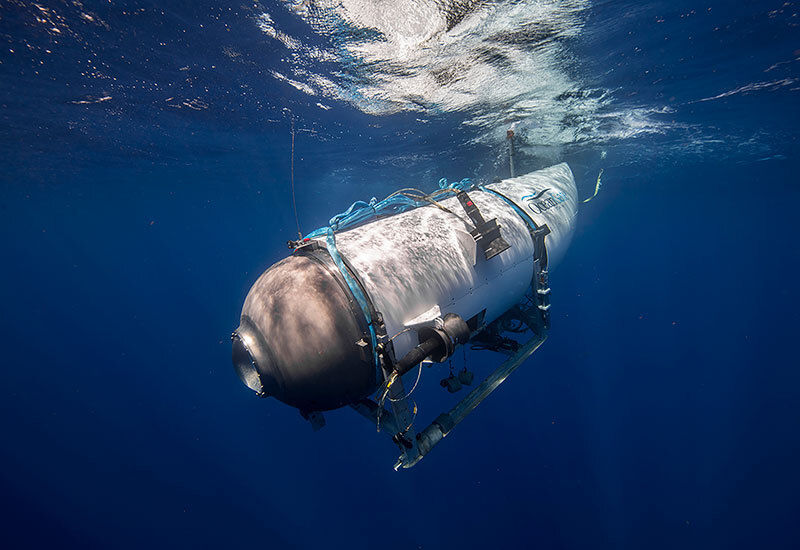Underwater noises have been detected in the search area for the missing submersible that was on an expedition to the Titanic's wreckage, the U.S. Coast Guard said overnight.
The underwater noises were detected by Canadian aircraft, and officials have relocated remote operated vehicles to investigate the origin of the noises. So far, they haven't turned up anything.
Get New England news, weather forecasts and entertainment stories to your inbox. Sign up for NECN newsletters.
The Coast Guard said that data from the Canadian aircrafts has been shared with U.S. Navy experts for further analysis, which will be used for future plans amid the search. Three ships arrived on Wednesday morning to a unified command established for the search: The John Cabot, the Skandi Vinland and the Atlantic Merlin. The John Cabot has side scanning sonar capabilities and is conducting search patterns alongside the other ships.
The Coast Guard did not elaborate on what rescuers believed the noises could be. The vessel is estimated to have as little as a day’s worth of oxygen left if it is still functioning.
"I think when you're in the middle of a search and rescue case, you always have hope. That's why we're doing what we do," U.S. Coast Guard Capt. Jamie Frederick said at a Wednesday afternoon press conference. "With respect to the noises specifically, we don't know what they are, to be frank. The good news is I can tell you we're searching in the area where the noises were detected and we'll continue to do so."
Coast Guard officials are bringing in more ships and other vessels to search the more narrowly defined area, though the exact location and source of the sounds has not yet been determined. The full scope of the search was twice the size of Connecticut in waters 2 1/2 miles deep, Frederick said.
Retired Navy Capt. Carl Hartsfield, now the director of the Woods Hole Oceanographic Systems Laboratory, told a news conference Wednesday that the sounds have been described as “banging noises,” but warned that search crews “have to put the whole picture together in context and they have to eliminate potential manmade sources other than the Titan.”
The Coast Guard statement about detecting sounds underwater came after Rolling Stone reported that search teams heard “banging sounds in the area every 30 minutes.”
Race against time to find missing sub
Three C-17 transport planes from the U.S. military have been used to move commercial submersible and support equipment from Buffalo, New York, to St. John’s, Newfoundland, to aid in the search, a spokesperson for U.S. Air Mobility Command said.
The Canadian military said it provided a patrol aircraft and two surface ships, including one that specializes in dive medicine. It also dropped sonar buoys to listen for any sounds from the Titan.
In addition to an international array of ships and planes, an underwater robot had started searching in the vicinity of the Titanic and there was a push to get salvage equipment to the scene in case the sub is found.
Three search vessels arrived on-scene Wednesday morning, including one that has side-scanning sonar capabilities. Authorities pushed to get salvage equipment to the scene in case the submersible is found.
"This is a search and rescue mission, 100%," Frederick said. "We are smack dab in the middle of a search and rescue and we will continue to put every asset we have to find the Titan and the crew members."
But even those who expressed some optimism warned that many obstacles remain: from pinpointing the vessel’s location, to reaching it with rescue equipment, to bringing it to the surface — assuming it’s still intact — before the passengers’ oxygen supply runs out.
The area of the North Atlantic where the Titan submersible went missing on Sunday is prone to fog and stormy conditions, making it an extremely challenging environment to conduct a search-and-rescue mission, said Donald Murphy, an oceanographer who served as chief scientist of the Coast Guard’s International Ice Patrol.
What went wrong?
The Titan, operated by OceanGate Expeditions, lost communication about an hour and 45 minutes into its excursion, which began on Sunday morning. Now, it's the center of an international search, one that authorities have called "very complex."
The Titanic sank about 400 miles off the coast of Newfoundland, Canada, in 1912. The search for the Titan is ongoing, about 900 miles east of Cape Cod in waters that are around 13,000 feet deep.
Questions remain about how teams could reach the lost submersible, which could be as deep as about 12,500 feet below the surface near the watery tomb of the historic ocean liner. Newly uncovered allegations also suggest there had been significant warnings made about vessel safety during its development.
Who's on board the Titan sub?
Lost aboard the vessel is pilot Stockton Rush, the CEO of the company leading the expedition. His passengers are a British adventurer, two members of a Pakistani business family and a Titanic expert.
The search for the missing vessel has drawn international attention. In Dubai, where the missing British adventurer Hamish Harding lives, Crown Prince Hamadan bin Mohammed Al Maktoum wrote: “Dubai and its people pray for their safety and hopeful return home.”
Others aboard include Pakistani nationals Shahzada Dawood and his son Suleman, whose eponymous firm invests across the country. In Pakistan's port city of Karachi, employees at his firms said they prayed for the two's safe return, as did government officials. French explorer and Titanic expert Paul-Henry Nargeolet also was on the vessel.
The Associated Press contributed to this report.



